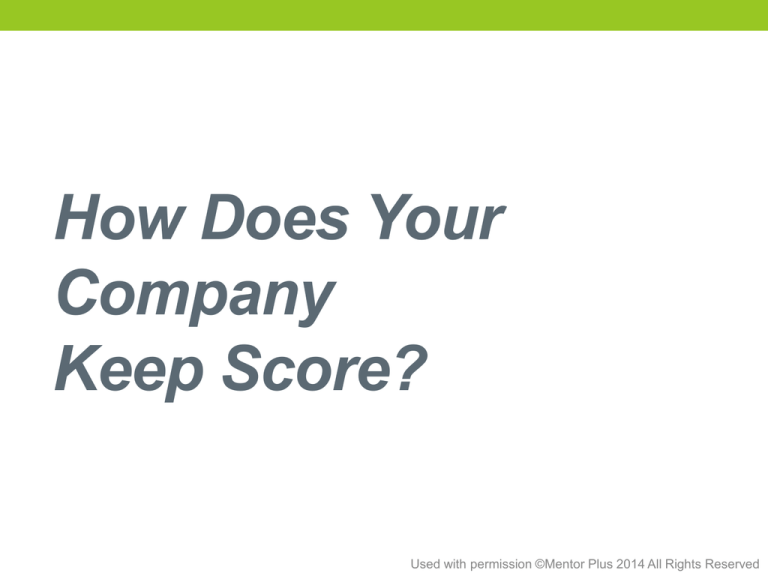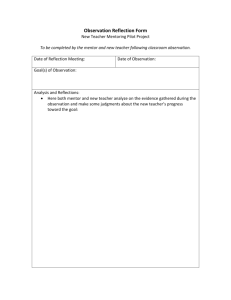
How Does Your
Company
Keep Score?
Used with permission ©Mentor Plus 2014 All Rights Reserved
Most companies keep
score this way:
Revenue - Expenses =
Net Profit
But this is only part of The Profit Equationsm . . .
Used with permission ©Mentor Plus 2014 All Rights Reserved
How do we identify Lost Opportunity?
A business is made up of:
Inputs
Activities
Outputs
In other words, a company is made up of various people
performing various activities
day. The Lost Opportunity lies in
People Xeach
Process
not measuring, managing, and leveraging those activities on a realtime basis.
Used with permission ©Mentor Plus 2014 All Rights Reserved
Truth #1
Your company’s profitability
depends on how well your people
consistently perform specific
activities.
This leads us to the other half of the formula that drives
The Profit EquationSM in business which is:
Activities drive Profits
People x Process = Profit
Used with permission ©Mentor Plus 2014 All Rights Reserved
The Profit Equation creates a link between:
SM
Traditional Financial Indicators
Revenue - Expenses = Profit
and
Key Performance Indicators (KPIs)
People X Process = Profit
In doing so, we can provide you with better
information to make critical decisions.
And… provide real-time feedback to
your team about its performance.
Used with permission ©Mentor Plus 2014 All Rights Reserved
A Real Life Example
In Football there are
three levels of
scoring
In Business there are
three corresponding
levels of scoring
1) Touchdowns
2) Offense/Defense Specialty Teams
3) Individual
Performance
1) Profit/Loss
2) Activity/Profit
Centers
3) Individual
Performance
Used with permission ©Mentor Plus 2014 All Rights Reserved
In football, performance is measured, and
compensation is based, on three levels of scoring:
1) How the team performs as a whole
2) How each specialty team performs
3) And how each individual performs.
Armed with the right information, coaches are able to make realtime adjustments to their strategy, while the game is still in play.
The result is each player understands exactly what is expected of
him/her each play of each game.
Used with permission ©Mentor Plus 2014 All Rights Reserved
In business, the availability of real-time feedback on performance
is limited and there isn’t always a clear link between compensation
and performance. A true KPI has a direct correlation to your
company goals and serves as an indicator for the outcome of the
“game” while it is still in play.
Unfortunately, many employees aren’t even sure what the
“rules of the game” are, not to mention how they are
being scored.
It’s no wonder many business owners become frustrated
with the performance of their team.
Used with permission ©Mentor Plus 2014 All Rights Reserved
Truth #2
People perform best when they
understand the “rules of play” and
the scoring method is clear.
Used with permission ©Mentor Plus 2014 All Rights Reserved
Once again, our goal is to
create a link between:
Traditional Financial Indicators
Revenue - Expenses = Profit
and
Key Performance Indicators
People x Process = Profit
Used with permission ©Mentor Plus 2014 All Rights Reserved
The benefits for doing so are quite
compelling.
Let’s take a look . . .
Used with permission ©Mentor Plus 2014 All Rights Reserved
Truth #3
Small incremental changes in key
areas (activities) can have a
profound effect on the bottom line.
Used with permission ©Mentor Plus 2014 All Rights Reserved
Four key areas to be measured in
business could be:
1) Finance
2) Customers
3) Operations
4) People
Used with permission ©Mentor Plus 2014 All Rights Reserved
Sample Financial KPIs
• Account Receivables
• Collection days
• Write-offs
• Accounts Payable
• Discounts taken
• Net Asset Turnover
• Return on Investment
Used with permission ©Mentor Plus 2014 All Rights Reserved
Sample Customer Marketing/Sales
KPIs
• Acquisition Rate
• Leads Generated vs. Closing Rate
• Cost of acquiring new customer/source
• Average & Cumulative Sales per customer/source
• Attrition Rate
• Reasons for leaving
• Customer Delight
• Referrals/customer/source
• Lifetime Value of a Customer
Used with permission ©Mentor Plus 2014 All Rights Reserved
Sample Operational KPIs
• Inventory turns
• Labor hours
• Turn-around time
• Cost of goods
• Re-work, Errors, Returns, etc.
• Down time
• Maintenance costs
Used with permission ©Mentor Plus 2014 All Rights Reserved
Sample People Management KPIs
• Employee satisfaction
• Strategic Intelligence
• Employee suggestions for improvement
• Company I.Q. - Innovation Quotient
• Employee turnover
• Training costs/employee
• Cost of acquiring an employee
• Absenteeism
• Injuries
Used with permission ©Mentor Plus 2014 All Rights Reserved
The Balanced Scoreboard
A truly balanced
approach to KPI
Measuring and
Monitoring also
addresses Finance,
Operations, Mgmt,
and Mktg./Sales
from these four
perspectives.
Internal
Short Term
Long term
External
Used with permission ©Mentor Plus 2014 All Rights Reserved
It’s likely you would have several KPIs in
each area of business
Internal
Finance
Long
term
Finance
Short
Term
External
Internal
Long
term
Finance
Finance
Long
term
Operation
s External
Short
Term
People
Mgmt
Short
External
Term
Internal
Internal
Finance
Long
term
Customers
Short
Term
External
Used with permission ©Mentor Plus 2014 All Rights Reserved
Various KPIs are monitored on different cycles
• Some weekly
• Some monthly
• Some quarterly
• Some annually
Used with permission ©Mentor Plus 2014 All Rights Reserved
Once we’ve selected the KPIs that best represent the critical
activities in your business, we create a “Flash Report” that might
look like this:
Flash Report for the period of: _______
ACTIVITY
Avg. Sale/order
Collection Days
New Orders Received
Proposals sent vs. closed
% Order Accuracy
% Orders filled within 24 hours
% of items on back order
Returns - Damaged Goods
Customer Complaints
Employee Absenteeism/Tardiness
ACTUAL
GOAL
%+-
Used with permission ©Mentor Plus 2014 All Rights Reserved
No More Lop-sided Coaching
Balanced Scoreboard
=
Better Decision Support
Used with permission ©Mentor Plus 2014 All Rights Reserved
Armed with better information ...
Now it’s time to engage and empower
the team to improve the numbers.
Used with permission ©Mentor Plus 2014 All Rights Reserved
Here are the Four Steps
to make that happen ...
Used with permission ©Mentor Plus 2014 All Rights Reserved
Step #1 - Explain the “Rules of
Play”
Simply put, when we identify the Key Performance Indicators
for each area of business and educate the team about the link
between their performance and the financial realities of the
business, we will have taken the first step toward Business
Literacy. In doing so, we establish new, measurable standards
of performance to which everyone can adhere.
Used with permission ©Mentor Plus 2014 All Rights Reserved
Step #2 - Post the Score
The team needs regular and
consistent feedback about their
performance. Without this, they will
cease to care.
Used with permission ©Mentor Plus 2014 All Rights Reserved
Step #3 - Recognize Effort
It may take some time for changes to appear on the
bottom line and not every effort will have an
immediate, discernable result, but it’s important to
recognize the effort along the way.
Used with permission ©Mentor Plus 2014 All Rights Reserved
Step #4 - Reward Improvement
Rather than giving arbitrary raises and bonuses,
now you can reward your team based on real
performance measures.
In doing so, you’ll find your team ready, willing, and
able to support your overall business goals.
Used with permission ©Mentor Plus 2014 All Rights Reserved
The final truth about business:
What gets measured gets done.
What gets rewarded gets done again.
Measurement drives performance
Used with permission ©Mentor Plus 2014 All Rights Reserved
Discussion:
How does this apply to your business?
• How does your company keep score?
• Is it based on the performance of the company as
a whole?
• Is it based on the performance of specialty teams
within the company?
• Is it based on individual contributions?
• What measures do you currently track?
• How do you share them with the team?
• Are they linked to compensation?
Used with permission ©Mentor Plus 2014 All Rights Reserved



